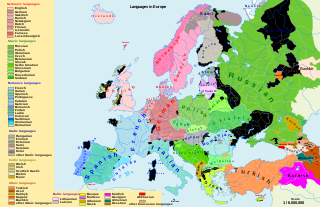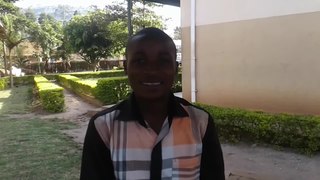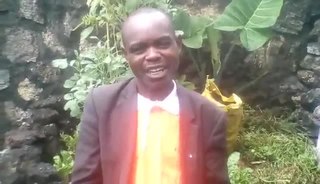Related Research Articles

There are over 250 languages indigenous to Europe, and most belong to the Indo-European language family. Out of a total European population of 744 million as of 2018, some 94% are native speakers of an Indo-European language. The three largest phyla of the Indo-European language family in Europe are Romance, Germanic, and Slavic; they have more than 200 million speakers each, and together account for close to 90% of Europeans.
Masaba (Lumasaaba), sometimes known as Gisu (Lugisu) after one of its dialects, is a Bantu language spoken by more than two million people in East Africa. The Gisu dialect in eastern Uganda is mutually intelligible with Bukusu, spoken by ethnic Luhya in western Kenya. Masaba is the local name of Mount Elgon and the name of the son of the ancestor of the Gisu tribe. Like other Bantu languages, Lumasaba nouns are divided into several sets of noun classes. These are similar to the genders in Germanic and Romance languages, except that instead of the usual two or three, there are around eighteen different noun classes. The language has a quite complex verb morphology.

Ankole was a traditional Bantu kingdom in Uganda and lasted from the 15th century until 1967. The kingdom was located in south-western Uganda, east of Lake Edward.
Haya (Oruhaya) is a Bantu language spoken by the Haya people of Tanzania, in the south and southwest coast of Lake Victoria. In 1991, the population of Haya speakers was estimated at 1,200,000 people. Its closest relative is the Nyambo language and it is also closely related to the languages of southwest Uganda such as Nkore-Kiga, Rutooro and Runyoro which all form a group called Rutara.
Nyoro or Runyoro is a Bantu language spoken by the Nyoro people of Uganda. It has two dialects: Runyoro proper and Rutagwenda. A standardized orthography was established in 1947. It's most closely related to Rutooro.
Nkore is a Bantu language spoken by the Nkore ("Banyankore") of south-western Uganda in the former province of Ankole, as well as in Tanzania, the DR Congo, Rwanda and Burundi.

Kiga is a Great Lakes Bantu language of the Kiga people (Bakiga). Kiga is a similar and partially mutually intelligible with the Nkore language. It was first written in the second half of the 19th century. Kiga is largely spoken in the ancient Kigezi region which includes about 5 districts, namely Rubanda, Rukiga, Kabale, Kanungu and some parts of Rukungiri. As of 2021, Kiga is spoken natively by about 1.3 million people in Uganda.
The Hororo or Bahororo are a Bantu-speaking ethnicity mainly residing in the north of the former Kigezi District in southwestern Uganda. In 1905, they were described by a British officer as a "quiet, inoffensive people" who owned cattle. They are made up mostly of the Hima ethnic group and the Iru ethnic group. They reside mainly in Rujumbura in southwestern Uganda and are related to the Banyankole, Banyoro, Batooro, Songora and Tutsi peoples respectively. Rujumbura was ruled by the BeeneKirenzi sub-clan with Omukama Karegyesa as their last king. The Bahororo speak a dialect of Nkore-Kiga, Ruhororo. They are subdivided into clans that are similar to those of the kingdom of Ankole. Unlike Ankole, which was ruled by the Hinda clan, Mpororo was led by the Bashambo clan.
Runyakitara is a standardized language based on four closely related languages of western Uganda:
Charles V. Taylor was an Australian linguist and the author of at least 19 books on topics ranging from African linguistics to ecclesiastical history. He was also known as a Bible teacher and a frequent Christian magazine contributor.
Bidjara, also spelt Bidyara or Pitjara, is an Australian Aboriginal language. In 1980, it was spoken by 20 elders in Queensland between the towns of Tambo and Augathella, or the Warrego and Langlo Rivers. There are many dialects of the language, including Gayiri and Gunggari. Some of them are being revitalised and are being taught in local schools in the region. The various dialects are not all confirmed or agreed by linguists.
The deaf sign language of the nations of the former Yugoslavia, known variously as Croatian Sign Language, Kosovar Sign Language, Serbian Sign Language, Bosnian Sign Language, Macedonian Sign Language, Slovenian Sign Language, or Yugoslav Sign Language (YSL), got its start when children were sent to schools for the deaf in Austro-Hungary in the early 19th century. The first two local schools opened in 1840 in Slovenia and in 1885 in Croatia.

Lega is a Bantu language, or dialect cluster, of the Democratic Republic of the Congo. There are two major varieties, Shabunda Lega and Mwenga Lega; Mwenga Lega, with about 10% of speakers, finds Shabunda difficult to understand. Kanu has been assigned a separate ISO code but is a dialect of Shabunda, and no more divergent than other dialects.
The Koma language is a language cluster belonging to the Duru branch of Savannas languages of Cameroon. Blench (2004) includes three varieties separated in Ethnologue, Koma Ndera, Gɨmne, and Gɨmnɨme; within Koma Ndera, speakers of the marginal dialects, Gomnome and Ndera, can scarcely understand one another, though both understand the central dialect, Gomme.
Kawahíva is a Tupi–Guarani dialect cluster of Brazil. The major variety is Tenharim.
Southern Luo is a dialect cluster of Uganda and neighboring countries. Although Southern Luo dialects are mutually intelligible, there are six ethnically and culturally distinct varieties which are considered to be separate languages socially.
Nyaneka or Haneca is a Bantu language of Angola. The Ngambwe "dialect" is now considered a distinct language.
Samia (Saamia) is a Bantu language spoken by the Luhya people of Uganda and Kenya. Ethnologue includes Songa as a dialect, but it may be a separate language.
Vili (Civili) is one of the Zone H Bantu languages, grouped with the Kongo clade.
The Songora or Shongora are a traditionally pastoralist people of the Great Lakes region of Central Africa located in Western Region, Uganda and Eastern Democratic Republic of the Congo. They have distinctive customs and speak Rusongora, a Bantu language that is similar to Runyankole and Runyoro. The Basongora population in Uganda was reported at numbering 15,897 people in the 2014 census. Although various community estimates put their population at around 40,000 and 50,000 people. Some Basongora also live in Eastern Congo.
References
- ↑ Nkore at Ethnologue (18th ed., 2015) (subscription required)
Kiga at Ethnologue (18th ed., 2015) (subscription required) - ↑ Jouni Filip Maho, 2009. New Updated Guthrie List Online
- ↑ https://glottolog.org/resource/languoid/id/nkor1241
- ↑ (Coote 2006)
- ↑ (Taylor 1985)